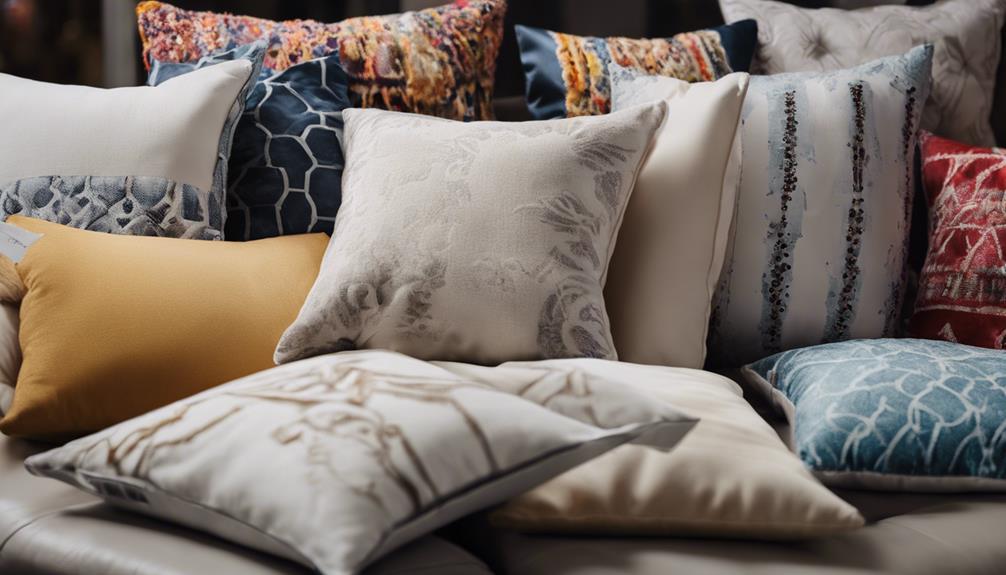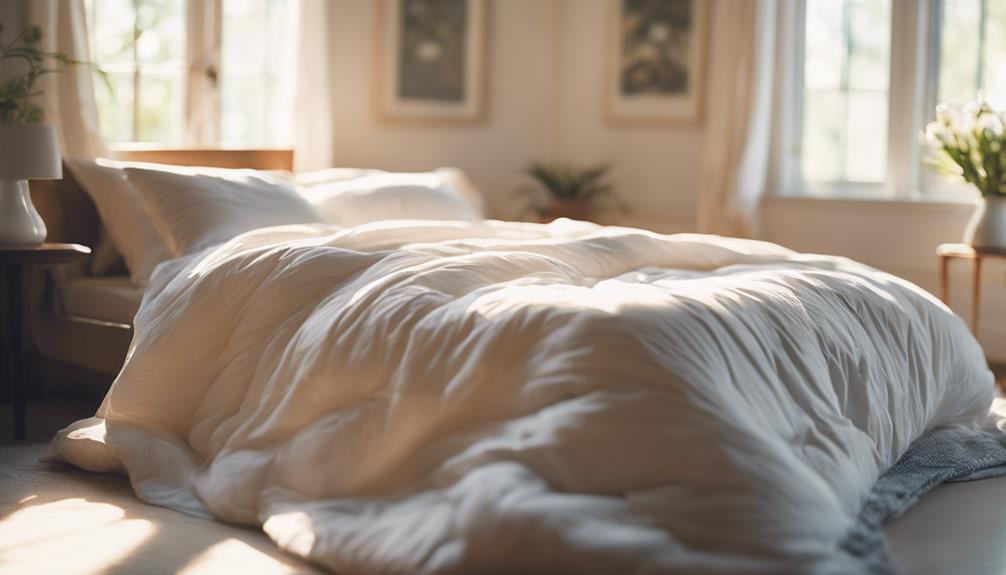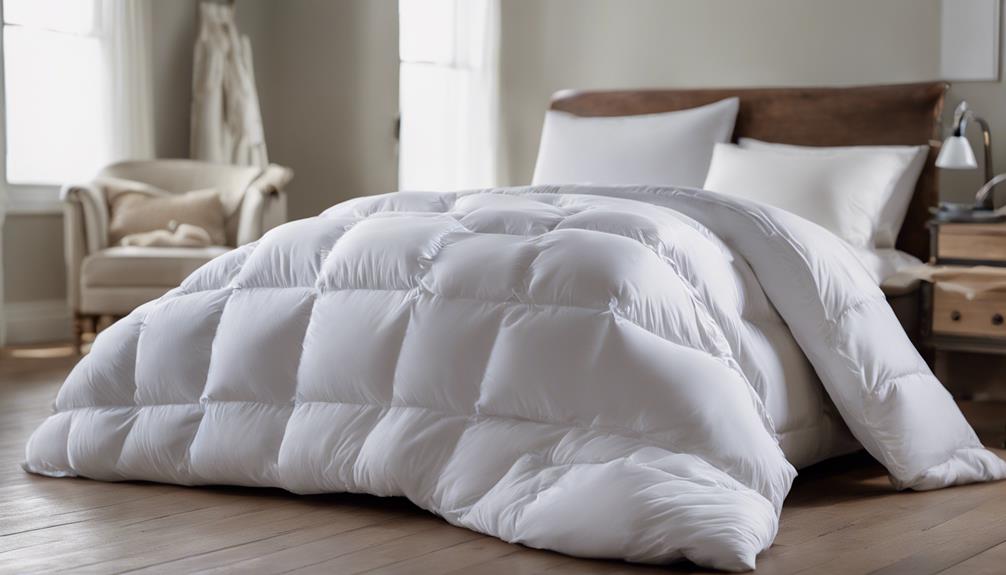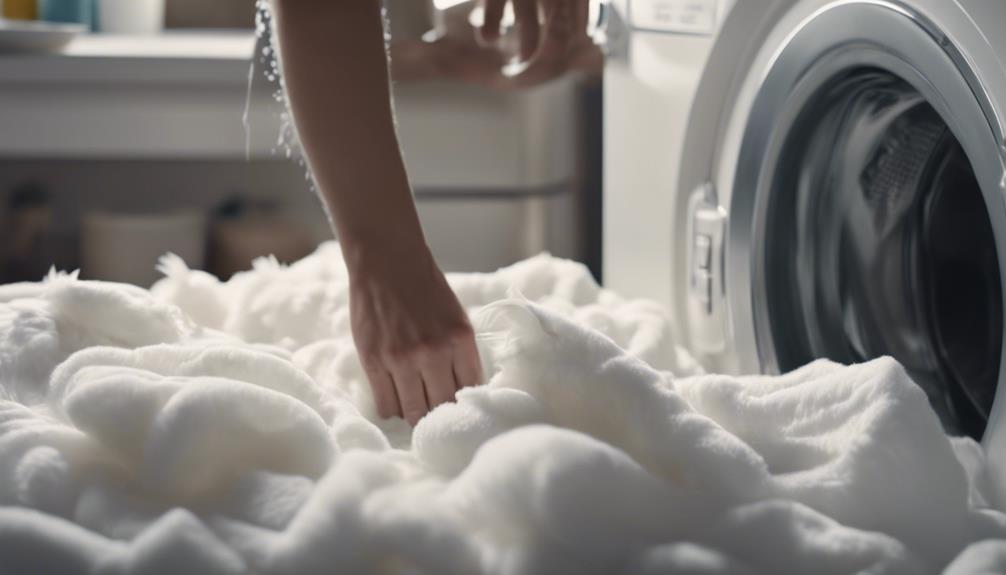When it comes to allergies, down comforters can be safe if properly maintained. Dust mites, not the down itself, typically trigger allergies. Regular washing in hot water and high heat drying help reduce allergens. Premium down can even be hypoallergenic with thorough cleaning. Industry standards guarantee purity for allergy-prone individuals. Remember to prioritize hypoallergenic options and look for tightly woven covers when choosing a down comforter. These practices, along with proper care, can lead to a cleaner sleep environment for allergy sufferers. For more tips on managing allergies with bedding, explore further into creating an allergy-friendly bedroom.
Key Takeaways
- Feathers in down comforters do not trigger allergies.
- Regular washing reduces dust mites, the main allergen.
- Opt for hypoallergenic down comforters.
- Industry standards ensure purity for allergy-free sleep.
- Proper maintenance minimizes allergens for a healthier environment.
Understanding Down Comforters and Allergies
When maintaining down comforters to reduce allergen accumulation, proper washing is essential for minimizing allergy risks. Dust mites, not the down or feathers themselves, are the main culprits behind allergic reactions.
By washing down comforters regularly, we can help eliminate these allergens and create a healthier sleeping environment. Premium down can even be hypoallergenic if it undergoes a thorough cleaning process to remove any allergen particles present. Industry standards make sure that hypoallergenic down meets high-quality and purity levels, reducing the risk of allergic reactions.
Understanding how to care for down bedding, such as reducing humidity levels and washing appropriately, is important for ensuring comfort while minimizing allergy risks associated with dust mites. By following these maintenance practices, we can enjoy the warmth and coziness of down comforters without compromising our health or comfort.
Dust Mites Vs. Down Comforters
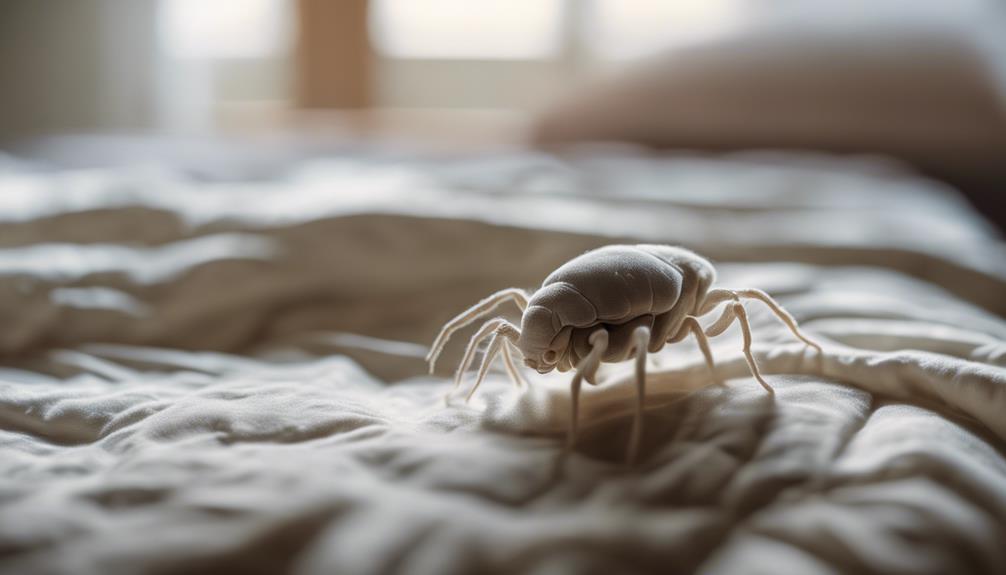
Dust mites are the main culprit when it comes to allergies in bedding, not down comforters. These tiny creatures thrive in warm, humid environments where dead skin cells are plentiful.
Regular cleaning and maintenance of bedding, including down comforters, can help keep dust mite levels at bay.
Dust Mites Thrive
While dust mites thrive in warm, humid environments such as bedding, down comforters themselves aren't the primary allergen culprits in bedding-related allergic reactions. Dust mites, along with dander, are the main triggers for allergies in bedding. These microscopic pests feed on skin cells and thrive in the cozy environment of bedding, including down comforters.
Regular washing and high heat drying of down comforters can help eliminate dust mites, reducing the risk of allergic reactions. It's essential to maintain bedding properly to minimize dust mites and allergens in the bedroom. When it comes to allergies, focusing on controlling dust mites through cleaning routines and proper care of bedding can make a significant difference.
Down Comforters Hypoallergenic?
Regular washing and proper maintenance of down comforters play a significant role in reducing the accumulation of dust mites and allergens, ensuring a hypoallergenic sleeping environment.
Feathers in down comforters themselves aren't allergenic, but dust mites that can inhabit bedding are the main culprits for triggering allergies. Even down alternative comforters can harbor dust mites, underlining the importance of regular cleaning routines.
To meet hypoallergenic standards, high-quality down is processed to be free from allergens, providing a safer choice for those with allergies. Industry practices like machine-controlled dedusting during down production help maintain purity and decrease allergen presence, ensuring a cleaner sleeping environment for allergy sufferers.
Allergy Symptoms Worsen?
Moving from our discussion on the hypoallergenic nature of down comforters, it's important to understand how allergy symptoms may worsen when comparing dust mites to down comforters.
When it comes to managing allergies related to bedding, here are some key points to keep in mind:
- Dust mites in bedding, not down comforters themselves, are the primary trigger for allergy symptoms.
- Feathers in down comforters don't cause allergic reactions, but dust mites thriving in bedding can exacerbate allergies.
- Regular washing and maintenance of bedding are essential to reduce dust mites and alleviate allergy symptoms.
Understanding the distinction between dust mites and down comforters is essential for ensuring a more allergy-free sleep environment.
Hypoallergenic Down Comforter Benefits

When it comes to bedding choices for allergy sufferers, hypoallergenic down comforters offer significant benefits in minimizing allergens. These specialized comforters are designed to undergo a rigorous cleaning process that removes dust mites, dander, and other potential allergens, making them suitable for those with allergies. The high-quality hypoallergenic down clusters in these comforters provide exceptional comfort without triggering allergic reactions. Meeting industry standards for purity and cleanliness, hypoallergenic down comforters offer a safe and cozy option for individuals prone to allergies.
| Benefits of Hypoallergenic Down Comforters |
|---|
| Minimize allergens |
| Provide comfort without allergic reactions |
| Meet industry standards for purity |
| Ensure cleanliness |
Proper Care for Allergy-Friendly Comfort
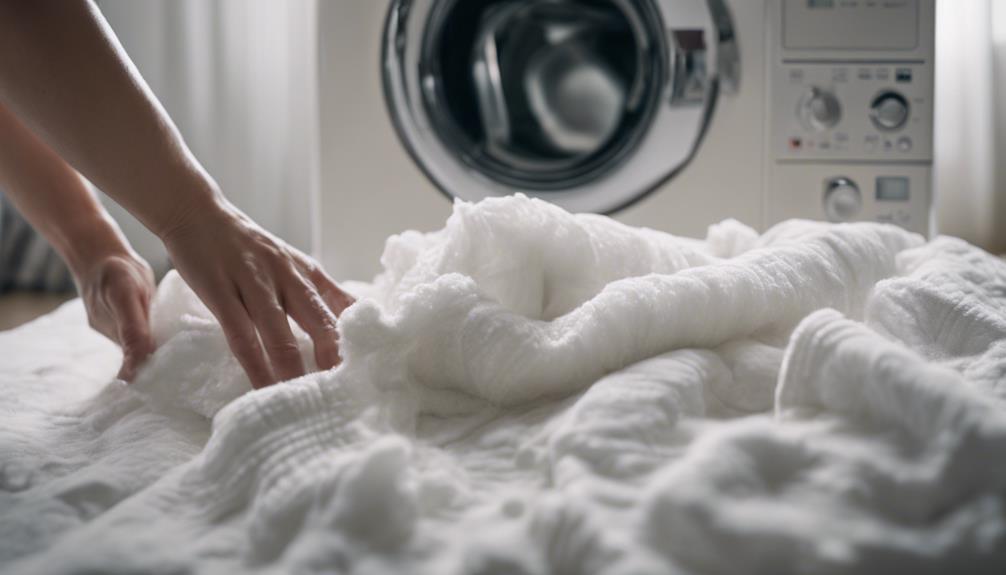
To maintain allergy-friendly comfort, it's crucial to establish a consistent routine for washing down comforters and using protective bedding covers. Here are three key steps to guarantee proper care for allergy-friendly comfort:
- Regular Washing: Wash down comforters frequently to remove dust mites and allergens that can accumulate over time. Follow the manufacturer's instructions for washing and drying to uphold the quality of the comforter.
- Use Protective Bedding Covers: Utilize zippered protectors for bedding to create a barrier that prevents dust mites from settling in your comforter. These covers are easy to clean and help maintain a healthier sleeping environment.
- Control Bedroom Humidity: Reduce humidity levels in your bedroom to discourage dust mite growth. Using a dehumidifier or proper ventilation can help create an environment that's less favorable for allergens to thrive, promoting better air quality for allergy sufferers.
Quality Down Vs. Allergenic Concerns
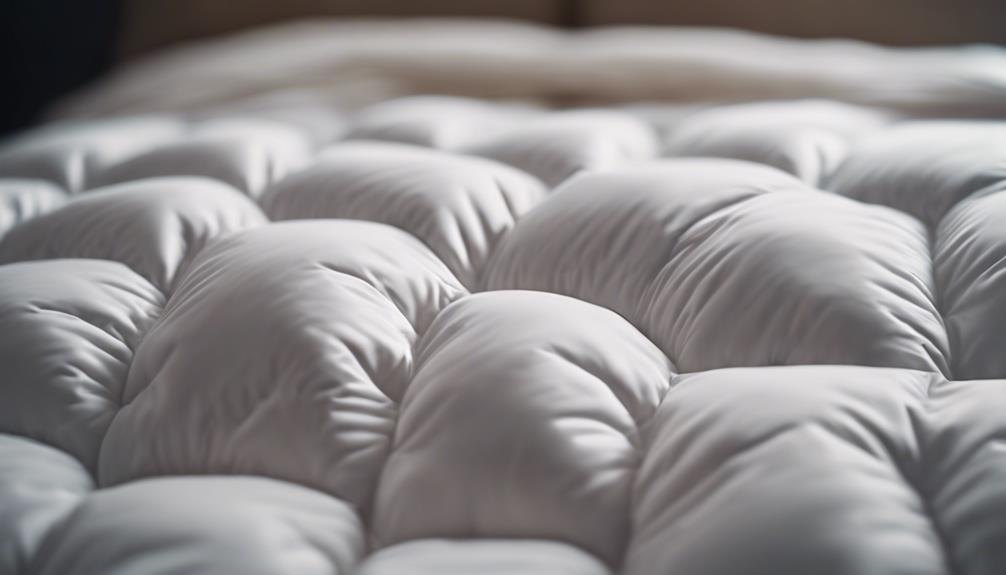
Many people believe that down comforters are bad for allergies, but genuine feather allergies are rare, with down and feathers not being potent allergens. Quality down can actually be hypoallergenic, meeting industry standards for purity and cleanliness.
Down Allergy Misconceptions
Quality down, with its rigorous cleaning process meeting hypoallergenic standards, guarantees purity and minimizes allergenic concerns for users.
Feathers themselves aren't allergenic but can harbor dust mites and dander, common allergens. Proper washing and maintenance of down comforters can help reduce allergy risks associated with dust mites.
Additionally, understanding the difference between allergens like dust mites and the quality of down can help address misconceptions about down comforters and allergies.
- Feathers aren't allergenic but can harbor dust mites and dander.
- Proper washing and maintenance of down comforters reduces allergy risks.
- Quality down undergoes rigorous cleaning to meet hypoallergenic standards.
Hypoallergenic Options Available
Amid concerns about allergens, exploring hypoallergenic options for down comforters is essential for ensuring a comfortable and allergy-friendly sleeping environment.
Quality down comforters can be a great choice for allergy sufferers if they're labeled as hypoallergenic. These comforters undergo thorough cleaning processes to remove allergen particles, ensuring they're free of dust mites and other common allergens.
Premium down clusters provide comfort without exacerbating allergies, especially when paired with hypoallergenic pillows. Machine-controlled dedusting procedures during down processing help maintain purity and reduce the risk of allergic reactions.
Regular washing of down bedding items at recommended intervals is important to maintain cleanliness and minimize allergen exposure for a restful night's sleep.
Cleaning and Maintenance Tips
To maintain a clean and allergy-friendly sleeping environment, regular cleaning and maintenance of down comforters play an essential role in reducing allergens like dust mites and mold. Here are some tips to keep your bedding allergy-free:
- Regular washing: Wash your down comforter and pillow in hot water and dry on high heat to eliminate dust mites.
- Quality matters: Opt for hypoallergenic down comforters that undergo rigorous cleaning processes to meet hypoallergenic standards.
- Protective measures: Use zippered protectors and natural cotton bed linen to maintain comfort and reduce allergens.
Washing Guidelines for Allergy Control

When aiming to control allergies, washing a down comforter in hot water of 130°F or above effectively eliminates dust mites and allergens. Using a mild detergent without bleach or harsh chemicals helps preserve the comforter's quality. Drying the comforter thoroughly on a high heat setting guarantees any remaining allergens are eliminated. It is recommended to wash down comforters every 6-12 months to reduce allergic reactions and maintain cleanliness. Following the manufacturer's care instructions and utilizing a large-capacity washer and dryer can aid in properly cleaning and caring for a down comforter.
| Washing Guidelines for Allergy Control | ||
|---|---|---|
| Step | Description | Tips |
| Wash Temperature | Use hot water (130°F or above) | Eliminates dust mites |
| Detergent | Use mild detergent without bleach | Preserves comforter quality |
| Drying Process | Dry thoroughly on high heat | Eliminates remaining allergens |
Choosing the Right Down Comforter
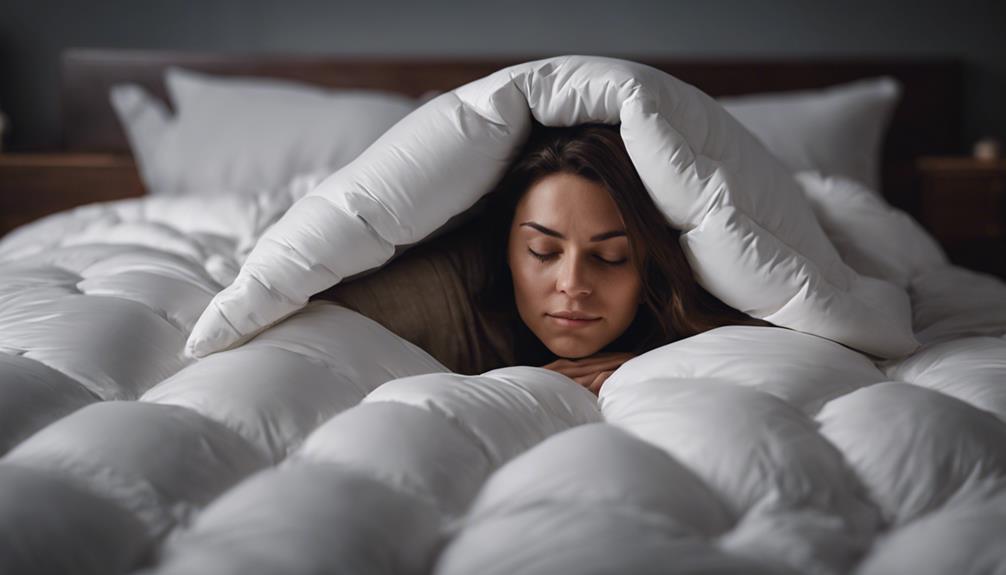
For individuals seeking the ideal down comforter to combat allergies effectively, prioritizing hypoallergenic options with tightly woven covers is essential. When selecting a down comforter, consider the following factors:
- Hypoallergenic Qualities: Look for down comforters that are specifically labeled as hypoallergenic, indicating they're less likely to trigger allergic reactions. These comforters have undergone special treatments to reduce allergens like dust mites.
- Quality and Cleaning Processes: Opt for high-quality down comforters that have been cleaned thoroughly to remove allergen particles. Brands that offer allergy-free warranties and use industry-standard hypoallergenic down ensure a purer product.
- Natural Materials: Choose down comforters made from natural materials like cotton, as recommended by Ohio State University. Natural fabrics like cotton allow the comforter to breathe, creating a cleaner sleeping environment that aids in allergy prevention.
Allergy Tips for Down Comforter Users
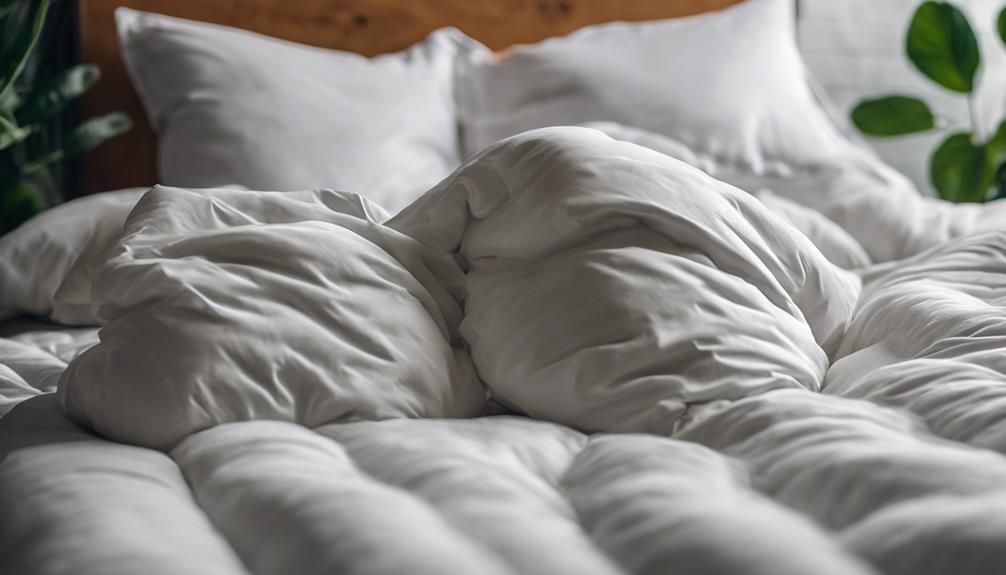
Regularly washing and drying down comforters on high heat can effectively eradicate dust mites, a common allergen, aiding in allergy prevention for users. Additionally, investing in hypoallergenic bedding materials like wool can further reduce allergic reactions for those who use down comforters. Remember, it's not the feathers causing the allergies, but rather the dust mites that accumulate in improperly cleaned bedding. To help you understand the importance of washing the bedding properly, here is a table highlighting some key tips:
| Washing the Bedding | Hypoallergenic Bedding Materials |
|---|---|
| Use hot water (130°F or above) when washing your comforter to exterminate dust mites. | Wool is a great hypoallergenic alternative to down, reducing the risk of allergies. |
| Dry your comforter on high heat to make certain any remaining dust mites are eliminated. | Bamboo and silk are also excellent choices for allergy-prone individuals. |
| Wash your bedding weekly to prevent dust mite buildup. | Cotton can be another hypoallergenic option for down comforter users. |
Creating an Allergy-Friendly Bedroom
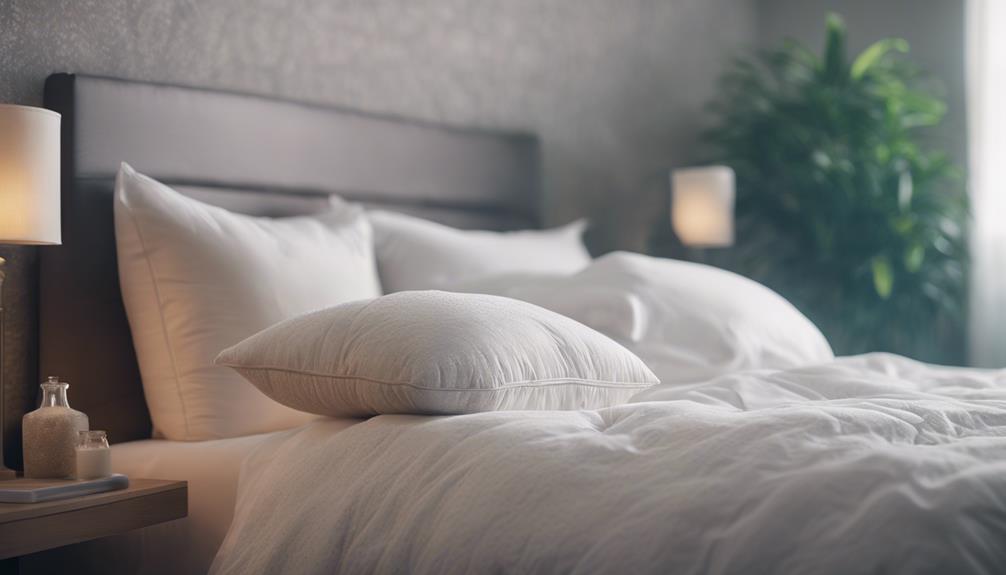
To create an allergy-friendly bedroom, consider encasing mattresses, pillows, and comforters with allergy protection covers to block dust mites and allergens. Here are three tips to help you achieve a hypoallergenic sleep environment:
- Use hypoallergenic bedding materials: Opt for bedding made from materials like wool, which can reduce allergic reactions and promote a healthier sleep environment.
- Regularly wash bedding: Wash your bed linen in hot water frequently to eliminate dust mites and allergens that can trigger allergies.
- Keep plush toys away: Avoid having stuffed animals and plush toys on the bed as they can harbor dust mites and other allergens.
Investing in Pacific Coast AllerRest bedding with allergen barrier fabric can provide added protection against dust mites and allergens, enhancing the overall allergy-friendliness of your bedroom. By following these tips and incorporating hypoallergenic practices, you can create a comfortable and safe space for a good night's sleep.
Frequently Asked Questions
Should I Get a Down Comforter if I Have Allergies?
We should consider several factors before deciding on a down comforter if we've allergies.
Proper care, like regular washing, can reduce allergens in down comforters. This maintenance is crucial for allergy sufferers, even with down alternatives.
High-quality down comforters can be hypoallergenic, making them a safe choice. So, with proper upkeep, a down comforter may be a suitable option for individuals with allergies.
Is Goose Down Okay for Allergies?
When it comes to allergies, goose down can actually be a good choice. Properly cleaned and sanitized high-quality goose down is hypoallergenic, making it suitable for allergy sufferers. Its natural resistance to dust mites and mold helps reduce allergy risks.
Opting for a reputable brand that offers hypoallergenic goose down can further prevent allergic reactions. So, if allergies are a concern, goose down might just be the cozy solution you've been looking for.
What Is the Best Comforter for Allergies?
When it comes to finding the best comforter for allergies, look for hypoallergenic options like those with high fill power or allergen barrier covers to reduce risks.
Down alternatives made of synthetic fibers can also be a good choice.
Regularly washing and drying your comforter on high heat can help eliminate dust mites and allergens.
Opt for bedding materials like traceable wool or organic cotton for natural hypoallergenic options.
Is a Down Comforter Hypoallergenic?
Yes, a down comforter can be hypoallergenic if properly cleaned and maintained. Premium down clusters undergo rigorous cleaning processes to remove allergen particles, meeting industry standards for purity. These high-quality down comforters provide comfort without triggering allergic reactions in most individuals.
Regular washing and using zippered protectors can further reduce allergens in down comforters. When cared for correctly, down comforters can be a good choice for allergy sufferers.
Can Using a Down Comforter Cause Allergic Reactions?
Many people wonder if using a down comforter can cause allergic reactions. While it is possible for some individuals to experience symptoms like sneezing, coughing, or itching due to down comforter allergy causes, it’s important to note that proper cleaning and maintenance can help minimize the risk of an allergic reaction.
Conclusion
To sum up, a down comforter can be a good choice for those with allergies, as long as it's properly cared for and maintained. Dust mites are the main allergen concern, but using a hypoallergenic down comforter and washing it regularly can help alleviate symptoms.
By following the proper guidelines for allergy control and choosing the right down comforter, you can create an allergy-friendly bedroom for a more comfortable sleep environment.

